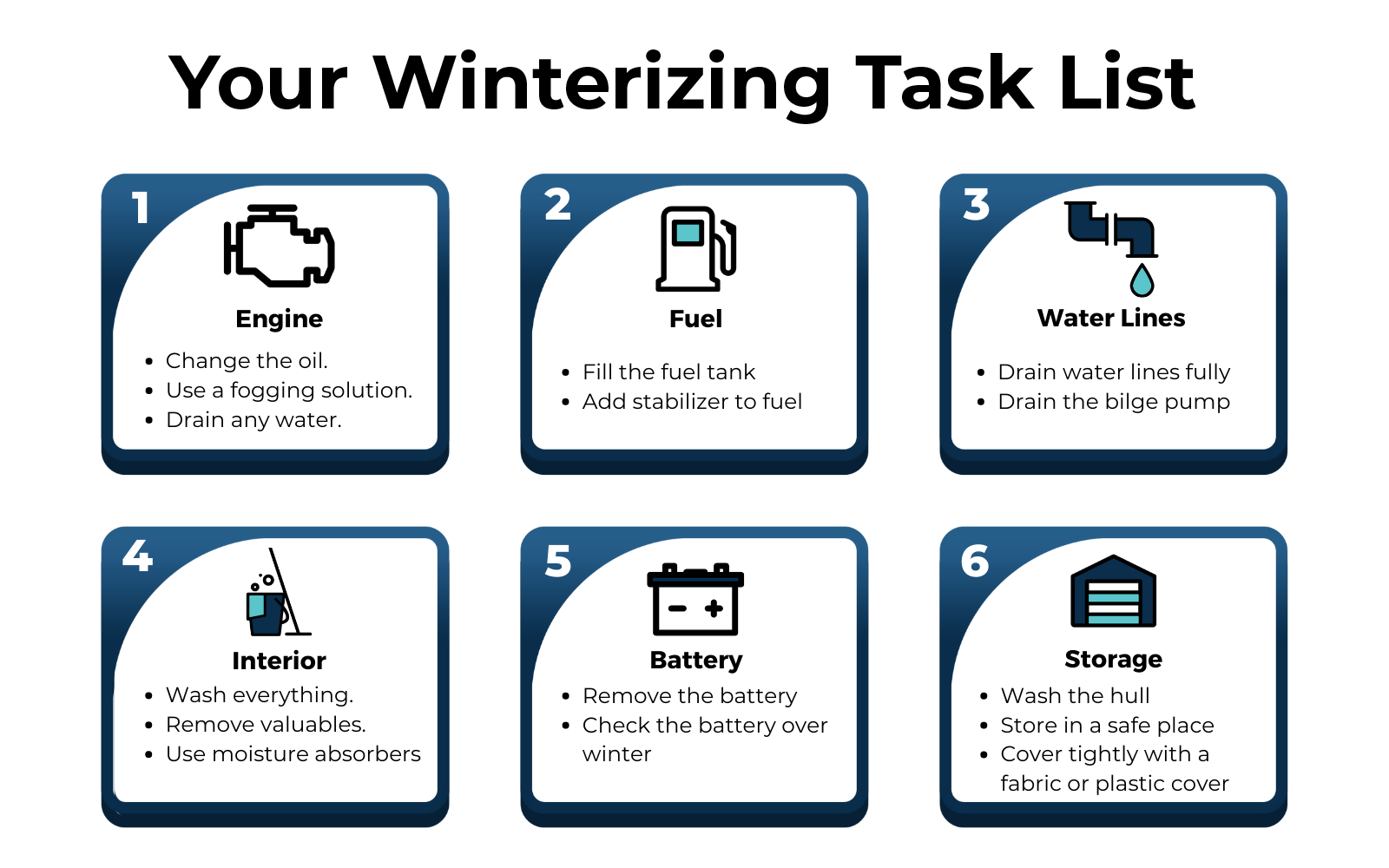How To Winterize Your Boat: A Guide

It’s that sad time of year again. It’s getting cold, and getting out on the water isn’t as fun as it was in the Summer sunshine. That means it’s time to pull the boat out and put it away for the winter. That’s right, we’re talking about winterizing your boat.
Now, some lucky people in the southern United States are probably thinking, “I don’t think I need to winterize; it’s never that cold.” Winterization is not only applicable in areas that receive extended periods of below-freezing weather. If, for whatever reason, you are not using your boat for several months, it’s best to take some precautions to ensure everything remains in good condition.
Sure, it’s not the most fun, but cleaning everything, flushing all the systems, and checking each individual part of your vessel is vital. It only takes part of a weekend, and can save a lot of money and time in the long run.
Not winterizing you boat can result in a ruined engine, the expansion of frozen fluids and corrosion can wreak havoc on your internal components. Mold and mildew will make your cabin look like a petri dish and leave a lingering stench. All in all, the cost of preventing these issues is much less than the mechanic’s bill in the Spring should you decide to forgo winterization.
Now the great news is, there are plenty of people that will winterize the boat for you. Your local marina, boat dealer, or mechanic knows the best way to make sure your boat gets through winter without any mishaps. However, if you want to try your hand at winterization, we compiled a few tips to help you get started.
There are 5 main areas that you need to cover: the engine, fuel system, water lines, deck and cabin, and hull. Taking care of these areas will prepare you for the winter. Please note, that before you start winterizing your boat, you should always consult the owner’s manual from the manufacturer. Every boat is different, and may require special treatment.

Engine:
Change your boat’s oil before you put it away for the season. If you don’t, moisture can build up and cause wear and tear on the entire system. If it’s starting to get cold, run the engine for a few minutes to heat everything up before you change the oil. It helps flush out the old oil and makes it easier for the new oil to coat everything.
Use a fogging solution to coat the engine’s cylinders, which protects the inside from corrosion. If you’re not sure what to buy, most manufacturers have “preferred” products for their engine. Look in your owner’s manual or do a quick google search for your engine manufacturer + fogging solution. The fogging process is simple, spray the solution into the engine’s air intake valve until there is none left. Check your manual for specific instructions.
The final step to prepare your engine for cold weather is draining any water in the cooling chambers. If left untouched, water could freeze and expand, potentially cracking the engine block.

Fuel:
Fill ‘er up! Seems counterintuitive, right? Why buy a full tank of gas if it’s just going to sit for 6 months. Well, any room in the fuel tank is space that condensation can creep into and then freeze. It will ruin any fuel you have left in the tank and potentially cause damage to the tank. The easy solution is to fill up the tank, so there is no extra room for moisture.
But you’re not quite done yet. You’ll want to add a fuel stabilizer to prevent evaporation throughout winter. Once that is added, run the engine for a few minutes to make sure all the treated fuel has made it through the boat’s systems.
Once the fuel is taken care of, it’s time to turn to your fuel filters and fuel/water separators. Make sure to replace these, as reusing a filter or separator could result in small particles getting drawn into the fuel system and damaging internal components.

Water lines:
Water is the enemy. When freezing temperatures hit, it will turn to ice and expand, causing cracks in vital systems or the hull. Just make sure that everything is completely drained. It’s easy enough; remove drain plugs and make sure everything is draining properly. A quick peek below the deck can verify that. Complete this process for any onboard water systems (bilge, plumbing, live wells, raw water washdowns, etc.). Check your owners manual for steps to take for those systems.

The interior:
Now that you have taken care of winterizing your boats internal systems, it’s time to treat the deck and cabin of your boat with an equal amount of love. Clean everything. Yes, everything. This is a great time to get the family involved in the process. Just say, “we’re starting a new tradition”, or “I’m passing on knowledge”. A little help makes the work go faster. First, remove valuables, electronics, lines, PFDs, fire extinguishers, flares, cushions, etc. Nothing should be left inside. After everything else is done, make sure to clean and check your safety equipment to determine if anything needs to be replaced. Clean drawers/gloveboxes, mop the deck, wipe down the cabin, and then let the whole boat air out. You want to ensure that mold and mildew do not have the chance to grow over the winter. Once everything has dried, place some moisture absorbers in the cabin. You can find these at most hardware stores; some common variants are “No Damp,” “Damp Away,” or “Sportsman’s Mate.”

Storage:
Where you store your boat is crucial, but the decision is typically already made for you. Do you have an indoor, heated space that can fit a boat without it getting in the way? If your answer is yes, then you are probably a marina or boatyard owner. If you do have a temperature-controlled space to keep your boat, that would be the ideal condition. However, for most people (including the team at Wavve Boating), that is not an option.
So we are leaving the boat outside all winter. Which is totally fine. It’s why we’ve done all this preparation. But there is still a bit more to do. After being in the water all summer, your hull has likely picked up a few hitchhikers. Barnacles are tricky creatures that will stick to your hull, props, rudders, struts, and trims. If part of your boat was underwater for an extended period, there’s a chance one of those little guys has called your boat home. These squatters are certainly not welcome, so next comes the job of removing the barnacles. A pressure washer is enough to make quick work of them, but you may need to sand some of the tough bits off. Once your hull is free of barnacles, clean and wax the outside of your hull.
The final step before covering the boat is removing your batteries and storing them in a warm place. Your garage or basement will do, as long as they are not too cold for too long. If you leave them in all winter, the cold will slowly deplete the battery. It’s also a good idea to check the charge every 30 to 90 days while they sit in your home. Nothing is worse than showing up at the boat ramp next Spring with a dead battery.
Now you’re ready to cover your boat. I recommend a fabric/plastic tarp cover. It’s a bit more expensive, but it’s useful all year round. Plus, it’s better than buying shrink wrap each year. All that is left to do is cover your boat and pack it away until next year.
This is a hard process to master. If it’s your first time winterizing your boat, you should try to get help from someone that’s been through the process at least once before. The last thing you want is a costly mistake.
About Wavve Boating
Wavve Boating is available on the Apple App Store and Google Play Store via two subscription options of $7.99/month or $45.99/year. For more information, visit us at https://wavveboating.com








